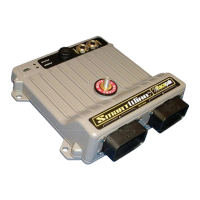Racepak
30402 Esperanza, Rancho Santa Margarita, CA 92688 USA
Phone: 949-709-5555 Fax: 949-709-5556 www.racepak.com
17
On/Off Conditions for Outputs
Accessed by clicking the On Condition button within any of the Output channel windows.
• Setpoint Control Channel: The pull-
down boxes #1-#10 allow selection of
channels, which are used to reference
for On/Off conditions of this output.
Channel name and its ID number are
shown.
• Operation: Not Equal To, Equal To,
Greater than, Greater than or Equal to,
Less than, Less than or Equal to Operators used for status of the Setpoint channel
• True Condition:
o Not Equal To, Equal To - Value used for the Setpoint Channel to be True.
o Greater than, Greater than or Equal to, Less than, Less than or Equal to – Value used for the
Setpoint Channel to become True. Requires a False condition to be set (*Hysteresis)
• False Condition
o Not Equal To, Equal To - Value used for the Setpoint Channel to be False.
o Greater than, Greater than or Equal to, Less than, Less than or Equal to – Value used for the
Setpoint Channel to become False. Requires a False condition to be set (*Hysteresis)
*Hysteresis –When the Greater than, Greater than or Equal to, Less than, Less than or Equal to is
selected, both a True and False condition must be entered. To prevent oscillation and/or chattering (i.e.
undesirable rapid changes between the two condition states, True or False), a small difference between
the True and False is required. Depending on the channel and desired condition, this difference can
either be small or large. If the difference is too small, this can cause the output channel to turn on/off
rapidly, causing undesirable effects. A larger difference in set points prevents chattering of the output
channel.

